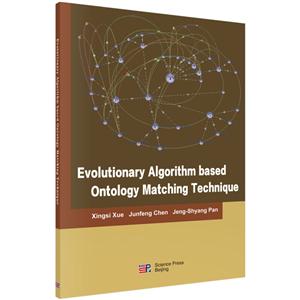-
>
决战行测5000题(言语理解与表达)
-
>
软件性能测试.分析与调优实践之路
-
>
第一行代码Android
-
>
深度学习
-
>
Unreal Engine 4蓝图完全学习教程
-
>
深入理解计算机系统-原书第3版
-
>
Word/Excel PPT 2013办公应用从入门到精通-(附赠1DVD.含语音视频教学+办公模板+PDF电子书)
Evolutionary Algorithm Based Ontology Matching... 版权信息
- ISBN:9787030601933
- 条形码:9787030601933 ; 978-7-03-060193-3
- 装帧:一般胶版纸
- 册数:暂无
- 重量:暂无
- 所属分类:>
Evolutionary Algorithm Based Ontology Matching... 内容简介
薛醒思、陈俊风、潘正祥主编的《基于进化算法的本体匹配技术(英文版)》描述了领域间的概念以及概念间的关系,是解决语义网上数据异质问题的方案。但是由于人类的主观性,同一个实体在不同本体中可能拥有不同的名称和描述方式,使得本体间存在异质问题。给定两个描述一系列离散的实体(实体可能是概念、关系和实例)的本体,确定这些本体间的关系的过程称为本体匹配,本体匹配可以有效地解决本体异质问题。当本体中的实体规模庞大的时候,本体匹配问题是一个复杂的(非线性问题且有很多局部*优解)和费时的(大规模问题)问题,因此近似的求解方法通常被用于确定本体匹配结果。源自这一观点,进化算法成为了求解本体匹配问题的有效方法。本书首先为本体概念层和实例层构建了不同的单目标、多目标和众目标模型,然后针对性地给出了各种进化算法(如混合进化算法,NSGA-II和MOEA/D)来求解这些模型。*后,还描述了各种提高基于进化算法的本体匹配技术性能的方法,如本体划分算法、紧凑编码方案、并行匹配框架和元模型辅助策略等,这些方法可以显著地减少运行时、内存消耗和算法所需的评价次数。
Evolutionary Algorithm Based Ontology Matching... 目录
Evolutionary Algorithm Based Ontology Matching... 作者简介
薛醒思(Xingsi Xue),received the Ph.D. degree in Computer Application Technology from Xidian University, in 2014. He is a professor at College of Information Science and Engineering, Intelligent Information Processing Research Center, Fujian Provincial Key Laboratory of Big Data Mining and Applications, Fujian Key Lab for Automotive Electronics and Electric Drive, Fujian University of Technology. He is a member of IEEE and ACM, and won 2017 ACM Xi'an Rising Star Award and IIH-MSP 2016 excellent paper award, 陈俊风(Junfeng Chen),received the Ph.D. degree from the College of Control Science and Engineering, Zhejiang University in 2011. Currently, she is an associate professor in the College of loT Engineering, Hohai University. She is a member of IEEE and ACM. 潘正祥(Jeng-Shyang Pan),received the Ph D. degree in Electrical Engineering from the University of Edinburgh in 1996. He is a professor at the College of Information Science and Engineering, Intelligent Information Processing Research Center, Fujian Provincial Key Laboratory of Big Data Mining and Applications, Fujian Key Lab for Automotive Electronics and Electric Drive, Fujian University of Technology. He was offered the Thousand Talents Plan in China in 2010.
- >
山海经
山海经
¥19.7¥68.0 - >
【精装绘本】画给孩子的中国神话
【精装绘本】画给孩子的中国神话
¥19.3¥55.0 - >
小考拉的故事-套装共3册
小考拉的故事-套装共3册
¥36.7¥68.0 - >
人文阅读与收藏·良友文学丛书:一天的工作
人文阅读与收藏·良友文学丛书:一天的工作
¥14.7¥45.8 - >
我从未如此眷恋人间
我从未如此眷恋人间
¥24.4¥49.8 - >
有舍有得是人生
有舍有得是人生
¥17.1¥45.0 - >
回忆爱玛侬
回忆爱玛侬
¥23.0¥32.8 - >
名家带你读鲁迅:故事新编
名家带你读鲁迅:故事新编
¥13.0¥26.0
-
C专家编程
¥41¥69 -
UG NX 11.0工程图教程-(含1DVD)
¥30.4¥59.9 -
网络爬虫进化论——从Excel爬虫到Python爬虫
¥55.5¥79 -
Python 数据分析基础
¥41¥69 -
Python 3.5从零开始学
¥26.4¥59 -
湖北交通文化
¥21.8¥46





















